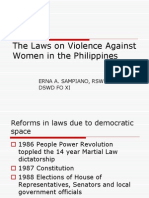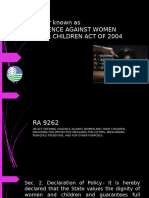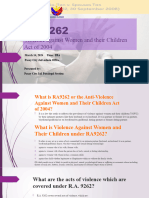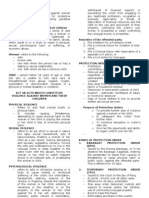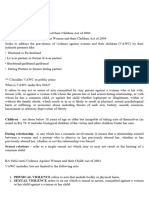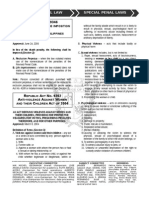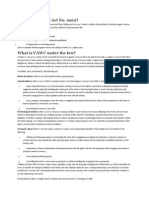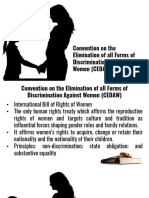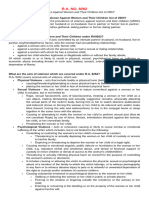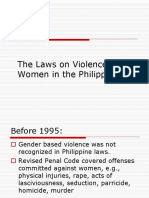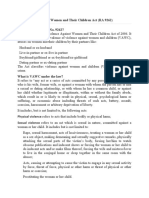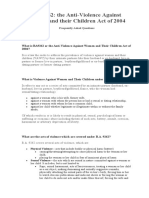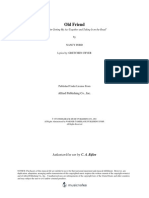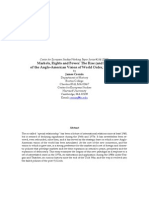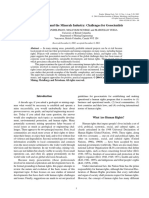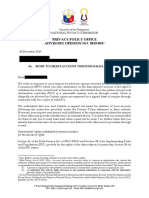RA 9282 Summary
RA 9282 Summary
Uploaded by
ckb18.adolfoCopyright:
Available Formats
RA 9282 Summary
RA 9282 Summary
Uploaded by
ckb18.adolfoOriginal Description:
Copyright
Available Formats
Share this document
Did you find this document useful?
Is this content inappropriate?
Copyright:
Available Formats
RA 9282 Summary
RA 9282 Summary
Uploaded by
ckb18.adolfoCopyright:
Available Formats
REPUBLIC ACT 9262: ANTI-VIOLENCE AGAINTS WOMEN & THIER
CHILDER ACT OF 2004 (VAWC)
And The Laws on Violence Against Women in the Philippines
Before 1995:
Gender based violence was not recognized in Philippine laws.
Revised Penal Code covered offenses committed against women, e.g.,
physical injuries, rape, acts of lasciviousness, seduction, parricide,
homicide, murder
Civil Law
Had discriminatory provisions on women, treated as subordinate to
husbands
Could not accept gifts from men other than their husbands without their
consent
Husband had sole administration of the conjugal partnership
1987 CONSTITUTION: State Policies
Sec. 2 adopts the generally accepted principles of international law as
part of the law of the land (CEDAW, CRC, other Conventions)
Full respect for human rights
Sec. 14. fundamental equality before the law of women and men
Sec. 14 The State shall protect working women by providing safe and
healthful working conditions
LAWS ON VAW since 1995
Anti-Sexual Harassment Act of 1995
Anti-Rape Act of 1997
Rape Victims Assistance Act (1998)
An Act penalizing matching of Filipino mail order brides (1998)
Anti-Trafficking in Persons Act of 2003
Anti-Violence Against Women and Their Children Act of 2004
RA 9262: Anti VAWC Act
Effective March 27, 2004
A special law protecting women and their children from all forms of abuse
Criminal statute
Civil action Temporary & Permanent Protection Order
With remedy of Barangay (village) Protection Order
Types of Violence covered
PHYSICAL
Battery (physical injuries)
Frustrated parricide
PSYCHOLOGICAL, EMOTIONAL
Marital Infidelity
Repeated verbal abuse
Public Humiliation
Threatening the woman that she will lose her child
Stalking or following the woman in her work-place, school or any
public or private place without justification
SEXUAL
Causing or attempting to make the woman or her child to perform
sexual acts (that do not constitute rape) by use of force, threats,
intimidation directed against the woman, her child, or her
immediate family
Prostituting the woman or her child
ECONOMIC
Denial of financial support or custody
What is Violence Against Women & their children (VAWC)?
any act or series of acts committed by any PERSON
against a WOMAN who is his wife, former wife, or with whom the person
has or had a sexual or dating relationships, or
with whom he has a common child, or
against her child/child under her care
Which result or is likely to result in physical, sexual, psychological harm or
suffering or economic abuse including threats of such acts,
Battery, assault, coercion, harassment or arbitrary deprivation of liberty
Who are liable?
Husbands;
Former Husbands;
Present & Former Boyfriends or Live-In Partners;
Those with whom the woman has a common child; or
Anyone with whom she has/had sexual or dating relationship.
Elements
Relationship, past or present
Married or not; living in or not
Sexual or dating relationship
Including lesbian relationships
With common child
Falling under Sec. 5 (punishable acts)
What is "Sexual Relations?
Sexual Relations refers to a single sexual act which may or may not result
in the bearing of a common child.
Example: A prostituted woman can avail of the remedies under the law if
she is being harassed or abused or publicly humiliated by a man with
whom she had a single sexual contact.
Sec. 5 Acts of VAWC
Causing, threatening, attempting to cause physical harm
Placing the woman or her child in fear of imminent physical harm
Attempting or compelling the woman or her child to engage in conduct
which they have a right to desist from, or to
depriving or threatening to deprive the woman or her child of custody or
access to her family
depriving them of financial support; insufficient financial support
Depriving or threatening to deprive the woman or her child of a legal right
Preventing the woman from engaging in any legitimate profession,
occupation, business or activity, or controlling her own money or
properties or solely controlling conjugal or common assets
Causing or attempting to cause the woman or her child to engage in any
sexual activity..., by force or threat, physical harm, intimidation directed
against the woman, her child, or immediate family *
Engaging in knowing or reckless conduct, personally or through another,
that alarms or causes substantial emotional or psychological distress
including:
(1) stalking
(2)entering or remaining in the property
Causing mental or emotional anguish, public ridicule, humiliation including
repeated verbal and emotional abuse*
denial of financial support or custody of minor children or denial of access
to the womans child *
* PRESCRIPTION PERIOD: 10 years. All others, 20 years
Protection Orders
Prohibition from threatening or committing, any of punishable acts
Removal and exclusion from the residence regardless of ownership,
temporarily or permanently where no property rights are violated
Stay away from petitioner, any designated family or household member
Temporary or permanent custody of child
Support automatic remittance of salary or income by employer
Dept of Social Welfare & Dev to provide shelter and social services
Purpose of Protection Orders
to prevent further acts of violence against a woman or her child.
to safeguard the victim from further harm
to minimize disruption in victims daily life
give her the opportunity and ability to regain control over her life.
Kinds of Protection Orders
Barangay Protecton Order 15 days; not extendible
Temporary Protection Order 30 days + (shall be renewed by court)
Permanent Protection Order
Temporary Protection Order
Issued by the Court on the day of filing
Ex parte ; Priority over all other cases
Effective for 30 days; extendible
Stay away order, temporary custody and support to woman and/or her
children, use of community/conjugal property
Bond to Keep the Peace
Enforceable anywhere in the country
No mediation; no conciliation
Permanent Protection Order
issued after notice and hearing
custody, support to the woman and/or her children
respondent to leave the residence permanently
with Bond to Keep the Peace
Who may file for Protection Orders (P.O.)
Offended party
Parents or guardians
Ascendants, descendants, collateral relatives within 4 th degree of
consanguinity or affinity
Social workers of DSWD or LGUs
Police officers
Punong Barangay or kagawad
Lawyer, counselor, therapist, healthcare provider
At least 2 citizens of the city or municipality who have personal knowledge
of the offense
Battered Woman Syndrome (BWS)
justifying circumstance
Perpetrator of crime against a woman with BWS shall not have custody of
children
Exemption from liability
NO CRIMINAL, CIVIL, ADMINISTRATIVE LIABILITY :
Any person, private individual, police authority, barangay official acting in
accordance with law, who
responds or intervenes without using violence or restraint greater than
necessary to ensure safety of the victim
Rights of victims
Right to be treated with respect & dignity;
Legal assistance; support services from DSWD, local governments
Privacy and confidentiality of records
Additional 10 day paid leave from work aside from present paid leave
benefits
Effectiveness of the law:
The law is a product of cooperation of womens rights organizations and
legislators, hence the comprehensive remedies
Protection Orders are being increasingly used by women to protect
themselves, get support, get back their minor children
Barangay protection order is available to poor rural women who have no
easy access to the courts
Supreme Court issued a Rule on VAWC, governs the trial of the case
Government officials, including judges are prohibited from mediating e.g.
to influence the woman to give up her reliefs
Local government units are tasked with education campaign to eliminate
VAW
Mechanism for government implementers and support services
Inter-Agency on VAW is provided in the law; government implementers
have Implementing Rules and Regulations enumerating their duties
Problem: lack of funds for training
Problems, gaps, lessons:
The law does not provide for appropriations, funding for training of
implementers and support services for the woman
Corruption in the judiciary, prosecution service
Low level of gender sensitivity among prosecutors
Ignorance of the law by police officers who are not in the womens and
childrens desks
Lack of quality gender sensitivity seminars for judges who are not family
court judges, and prosecutors
Misuse of the laws and rules by lawyers, e.g. retaliation suits against
women who have protection orders
You might also like
- Salient Features of Republic Act 9262 or Anti-Violence SlideDocument19 pagesSalient Features of Republic Act 9262 or Anti-Violence SlidePevi Mae Jalipa67% (12)
- Position Paper SampleDocument8 pagesPosition Paper Sampleckb18.adolfo100% (2)
- Performance Evaluation Form (Staff)Document1 pagePerformance Evaluation Form (Staff)ckb18.adolfoNo ratings yet
- The Laws On Violence Against Women in The Philippines: Erna A. Sampiano, RSW DSWD Fo XiDocument33 pagesThe Laws On Violence Against Women in The Philippines: Erna A. Sampiano, RSW DSWD Fo XiRabhak Khal-HadjjNo ratings yet
- EGMGPLVAW Powerpoint (Rowena Guanzon)Document34 pagesEGMGPLVAW Powerpoint (Rowena Guanzon)Shannon SantosNo ratings yet
- VAWCDocument33 pagesVAWCElla Marie Sanico-Abustan100% (1)
- Ra 7610Document37 pagesRa 7610olbes maricelNo ratings yet
- The Laws On Violence Against Women and Children in The PhilippinesDocument32 pagesThe Laws On Violence Against Women and Children in The PhilippinesCHARLOTTE GALLEGONo ratings yet
- VAWCDocument36 pagesVAWCkristinemaemutiaNo ratings yet
- Elvira Q. Tamondong: Teacher 3Document34 pagesElvira Q. Tamondong: Teacher 3Margie RodriguezNo ratings yet
- VAWCDocument39 pagesVAWCIsrael EspinozaNo ratings yet
- Vaw FinalDocument8 pagesVaw FinalBreth1979No ratings yet
- Ra 9262 - Vawc 1Document37 pagesRa 9262 - Vawc 1Sta LuciaNo ratings yet
- Ra 9262Document14 pagesRa 9262Sixtyfour SacNo ratings yet
- RA 9262 Lecture Frequently Asked QuestionsDocument14 pagesRA 9262 Lecture Frequently Asked Questionsgenesis kiakiNo ratings yet
- Vawc by DilgDocument36 pagesVawc by DilgGee RidadNo ratings yet
- Anti Violence Against Women and Their Children Act RA9262 Rev1Document26 pagesAnti Violence Against Women and Their Children Act RA9262 Rev1George GammadNo ratings yet
- Gerry Violencem Against WomenDocument4 pagesGerry Violencem Against WomenMariecris Barayuga Duldulao-AbelaNo ratings yet
- Violence Against Women and Their ChildrenDocument85 pagesViolence Against Women and Their ChildrenCATHERINE CAPANANGNo ratings yet
- The Anti-Violence Against Women & Their Children Act of 2004Document37 pagesThe Anti-Violence Against Women & Their Children Act of 2004Floramae Celine BosqueNo ratings yet
- Annex 1 Republic Act 9262Document4 pagesAnnex 1 Republic Act 9262wilson siyNo ratings yet
- Republic Act 9262 or VAWC LectureDocument49 pagesRepublic Act 9262 or VAWC LectureLily PritchettNo ratings yet
- Anti-Violence Against Women and Their Children Act of 2004Document43 pagesAnti-Violence Against Women and Their Children Act of 2004Aiza CabenianNo ratings yet
- Woman-Refers To The Following:: Ex Parte Priority Over All Other CasesDocument3 pagesWoman-Refers To The Following:: Ex Parte Priority Over All Other Caseskristine_silangNo ratings yet
- VAWC LectureDocument23 pagesVAWC LectureFaith Roslyndale Fidés100% (3)
- CA 300 Complete NotesDocument7 pagesCA 300 Complete NotesmelmhyrrsagadonNo ratings yet
- Women and Children With Law ScaleDocument30 pagesWomen and Children With Law ScaleDeanette MichaelaNo ratings yet
- Week 9 - HRDocument23 pagesWeek 9 - HRHK FreeNo ratings yet
- LawsDocument3 pagesLawsRicky LovenutsNo ratings yet
- REPUBLIC ACT NO 9262 Anti VAWC (Briefer)Document14 pagesREPUBLIC ACT NO 9262 Anti VAWC (Briefer)marycris.lagdameoNo ratings yet
- UTS VAWCYDocument6 pagesUTS VAWCYbpltfsanpedroNo ratings yet
- Special Penal LawsDocument38 pagesSpecial Penal LawsArla Agrupis83% (6)
- What Is Republic Act No. 9262?Document3 pagesWhat Is Republic Act No. 9262?Ethan Zachary100% (2)
- R.A. 9262 Violence Against Women and ChildrenDocument11 pagesR.A. 9262 Violence Against Women and ChildrenJanna Monica YapNo ratings yet
- Among Policy AnalysisDocument8 pagesAmong Policy AnalysisJierodz GenganiaNo ratings yet
- Anti-Violence Against Women and Their Children Act (RA 9262)Document69 pagesAnti-Violence Against Women and Their Children Act (RA 9262)rafael.louise.roca2244No ratings yet
- Ra 9262 VawcDocument13 pagesRa 9262 VawcSheila Arenajo ArtilleroNo ratings yet
- Vawc PresentationDocument18 pagesVawc PresentationMerly FelizartaNo ratings yet
- Violence Against Women and Their ChildrenDocument3 pagesViolence Against Women and Their ChildrenDimpleNo ratings yet
- Anti Violence Against Women and Their Children Act RA 9262Document22 pagesAnti Violence Against Women and Their Children Act RA 9262Angelika MarrizeNo ratings yet
- RA 9262 VawcDocument41 pagesRA 9262 VawcRotchell Abila PelayoNo ratings yet
- 2024 Laws On Women SectorDocument106 pages2024 Laws On Women SectorizedfxNo ratings yet
- Philippine Laws On WomenDocument56 pagesPhilippine Laws On WomenElle BanigoosNo ratings yet
- Violence Against Women and Their Children (Vawc) Act of 2004 (R.A - 9262)Document32 pagesViolence Against Women and Their Children (Vawc) Act of 2004 (R.A - 9262)Dioso FeliceNo ratings yet
- Violence Against WomenDocument5 pagesViolence Against WomenLuiciaNo ratings yet
- Lesson+11 Philippine Laws on WomenDocument47 pagesLesson+11 Philippine Laws on WomenfranialkimNo ratings yet
- Crim ReportDocument29 pagesCrim ReportmelmhyrrsagadonNo ratings yet
- Ra 9262Document30 pagesRa 9262georgejoshuaabenesmendozaNo ratings yet
- Vawc - Republic Act 9262Document4 pagesVawc - Republic Act 9262Hue MitchyNo ratings yet
- MIDTERM REVIEWER - SPL (ELEMENTS)Document19 pagesMIDTERM REVIEWER - SPL (ELEMENTS)MONTILLA LicelNo ratings yet
- VAWC PresentationDocument35 pagesVAWC PresentationlyndoneNo ratings yet
- RA 9262: The Anti-Violence Against Women and Their Children Act of 2004 Frequently Asked QuestionsDocument10 pagesRA 9262: The Anti-Violence Against Women and Their Children Act of 2004 Frequently Asked QuestionsSimon WolfNo ratings yet
- Irr of Ra 9262 Anti Violence Against Women and Their Children Act of 2004Document21 pagesIrr of Ra 9262 Anti Violence Against Women and Their Children Act of 2004Christle PMDNo ratings yet
- VAWCDocument47 pagesVAWCKatherine PineNo ratings yet
- Anti-Violence A-WPS OfficeDocument2 pagesAnti-Violence A-WPS OfficeReymond PerezNo ratings yet
- RA 9262 - Frequently Asked Questions (VAWC)Document11 pagesRA 9262 - Frequently Asked Questions (VAWC)RA DionisioNo ratings yet
- Analysis VAWCDocument2 pagesAnalysis VAWCMelanie BiongNo ratings yet
- Ra 9262 Anti Vawc ActDocument39 pagesRa 9262 Anti Vawc ActDesireeNo ratings yet
- The Violence Against Persons (Prohibition) Act, 2015 & Rivers State Child's Right Law No, 10 2019From EverandThe Violence Against Persons (Prohibition) Act, 2015 & Rivers State Child's Right Law No, 10 2019No ratings yet
- Recognizing the signs of an abusive relationship: Get to understand Abusive relationships., #1From EverandRecognizing the signs of an abusive relationship: Get to understand Abusive relationships., #1No ratings yet
- Comprehensive Agrarian Reform Law - Report OutlineDocument19 pagesComprehensive Agrarian Reform Law - Report Outlineckb18.adolfoNo ratings yet
- Intro To Law ConsoDocument54 pagesIntro To Law Consockb18.adolfoNo ratings yet
- Intro To Law ConsoDocument54 pagesIntro To Law Consockb18.adolfoNo ratings yet
- Project On Crime Against Women in Assam FROM 2005 TO 2015: Submiited byDocument30 pagesProject On Crime Against Women in Assam FROM 2005 TO 2015: Submiited byRima TalukdarNo ratings yet
- Jus CogensDocument9 pagesJus CogensArthur AmolaNo ratings yet
- Racial and Gender Discrimination in The WorkplaceDocument3 pagesRacial and Gender Discrimination in The WorkplaceDavid Jonathan PoloNo ratings yet
- Sammy Lasco Kavinga V The People Appeal No 51Document5 pagesSammy Lasco Kavinga V The People Appeal No 51finesschisangaNo ratings yet
- ادارة الجودة الشاملةDocument104 pagesادارة الجودة الشاملةyyqyxtNo ratings yet
- 3 Generations of Human RightsDocument1 page3 Generations of Human RightsDzenan HakalovicNo ratings yet
- Module 2 - Lesson 4Document2 pagesModule 2 - Lesson 4Edzel Dwight GumiranNo ratings yet
- 201438766Document68 pages201438766The Myanmar TimesNo ratings yet
- Mob Lynching Article17Document12 pagesMob Lynching Article17RAMESH BABU TATAPUDINo ratings yet
- ThesisDocument57 pagesThesissanjayrsugandhiNo ratings yet
- Report of The Third South Asian People's SummitDocument220 pagesReport of The Third South Asian People's SummitMustafa Nazir Ahmad100% (1)
- Old Friend - C Major - MN0168851 - U5Document8 pagesOld Friend - C Major - MN0168851 - U5ceesNo ratings yet
- Senior Project by Elie BideDocument23 pagesSenior Project by Elie Bideapi-596980727No ratings yet
- Ilias Bantekas - Susan Nash, Barrister - International Criminal Law-Routledge-Cavendish (2007)Document637 pagesIlias Bantekas - Susan Nash, Barrister - International Criminal Law-Routledge-Cavendish (2007)ema-sofiaNo ratings yet
- Markets, Rights and Power: The Rise (And Fall?) of The Anglo-American Vision of World Order, 1975-2005 (WPS 164 2008) James Cronin.Document35 pagesMarkets, Rights and Power: The Rise (And Fall?) of The Anglo-American Vision of World Order, 1975-2005 (WPS 164 2008) James Cronin.Minda de Gunzburg Center for European Studies at Harvard UniversityNo ratings yet
- Persuasive Essay TPDocument3 pagesPersuasive Essay TPapi-255067517No ratings yet
- 903-MHz Linear AmplifiersDocument12 pages903-MHz Linear Amplifiersrm2kogk7baNo ratings yet
- Human Rights and The Minerals Industry: Challenges For GeoscientistsDocument16 pagesHuman Rights and The Minerals Industry: Challenges For GeoscientistsAdrian ValderramaNo ratings yet
- 4 Waves of Feminism by Martha RamptonDocument5 pages4 Waves of Feminism by Martha RamptonThoufiq KhaziNo ratings yet
- Racism in UK 1Document1 pageRacism in UK 1Oviedo RocíoNo ratings yet
- Best Team Memorial Respondent Rmlnlu SCC Online Moot 08 20 Faizan17ahamed Gmailcom 20220103 230556 1 24Document24 pagesBest Team Memorial Respondent Rmlnlu SCC Online Moot 08 20 Faizan17ahamed Gmailcom 20220103 230556 1 24Faizan ahamedNo ratings yet
- Human & Civil RightsDocument16 pagesHuman & Civil RightsMohindro ChandroNo ratings yet
- Implementation of Uniform Civil Code and Its ProblemDocument2 pagesImplementation of Uniform Civil Code and Its ProblemMukilan AloneNo ratings yet
- Annex B Intake SheetDocument1 pageAnnex B Intake SheetRomelyn BalbidoNo ratings yet
- Chapter 3: Ethics and Law in Corporate CommunicationDocument3 pagesChapter 3: Ethics and Law in Corporate CommunicationVarun AadarshNo ratings yet
- Bhabha Arendt's ChildrenDocument43 pagesBhabha Arendt's ChildrenIves RosenfeldNo ratings yet
- (Redacted) Advisory Opinion No. 2019-051 RIGHT TO DELETE ACCOUNT THROUGH E-MAILDocument3 pages(Redacted) Advisory Opinion No. 2019-051 RIGHT TO DELETE ACCOUNT THROUGH E-MAILGenel Roi VicencioNo ratings yet
- Case Analysis Comparision - Baby M Manji-1Document26 pagesCase Analysis Comparision - Baby M Manji-1api-372898116No ratings yet
- Human RightsDocument139 pagesHuman RightsImti Lemtur50% (2)
- Spini Doise. Organizing Principles of Involvement in Human Rights and Their Social Anchoring in Value Priorities.1998Document20 pagesSpini Doise. Organizing Principles of Involvement in Human Rights and Their Social Anchoring in Value Priorities.1998Luciana Lombas Belmonte AmaralNo ratings yet



